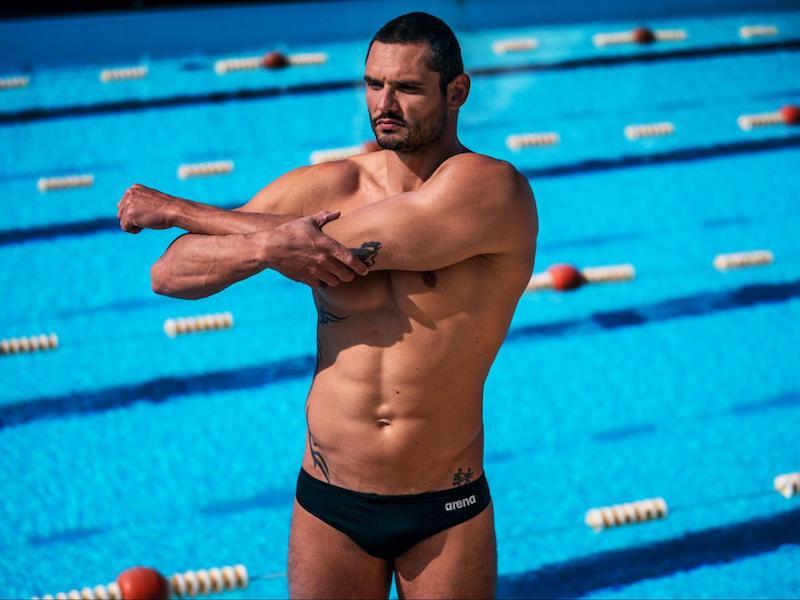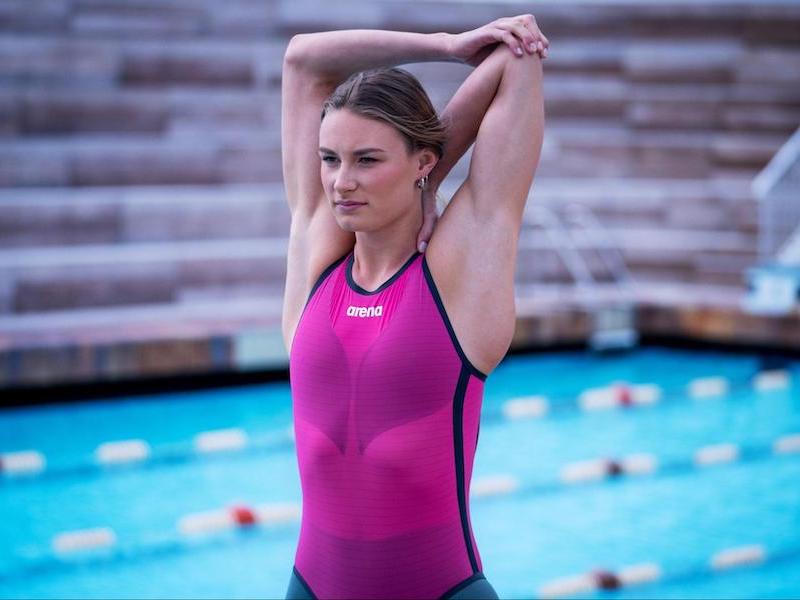Prepare to Race With These Swimming Warmup Exercises
Getting your muscles ready to work efficiently is extremely important before a swim workout but even more so before a race. Utilizing proper swimming warmup exercises will improve your race performance and reduce your risk of injury. Whether you are a beginner or looking for tips to improve the warmup you’ve been practicing for years, this article aims to teach you the best ways to prepare your body for a swim event.
First, we’ll look at the different stages of warming up during a swim meet and how you can loosen up on dry land and in the water. Then, we’ll cover research-backed TRX suspension training warmups for the specific swim strokes.
The Stages of Warming up at a Swim Meet
Before a swim meet begins, you’ll have time to perform an initial set of swimming warmup exercises in the water. This is great if you swim one of the first events, but for some swimmers, your event won’t come until much later, meaning you won’t receive all the benefits of your initial swim warmup. That’s why it’s important to plan out a warmup routine that works best for your schedule during the swim meet so you can avoid starting a race with cold and contracted muscles.
Let’s go over the stages of warming up during a swim meet so you can understand how and when you should get your blood flow going before your event. We’ll cover the dryland warmup, the general warmup before the meet starts, and a quick warmup before your event.
Dynamic Dryland Warmup
This is the first stage of swimming warmup exercises you should perform before you get in the water. It’s a good idea to practice a dynamic stretching routine before your general warmup and your second race-specific warmup. In fact, you should always stretch out before swimming, whether it’s swim training or competition.
The purpose of dynamic stretching exercises is to get your heart rate up, increase your body temperature, and get the blood flowing to your muscles. Perform dynamic stretching instead of static stretching. Static stretching has been linked to performance reductions, while dynamic stretching adequately prepares the body for athletic activity.
Dynamic warmup movements for the upper body include arm swings and arm circles. To get your heart rate up, perform jumping jacks and jump rope. For your lower body, loosen up your hamstrings, glutes, and hip flexors with lunges and squats.
You can also perform light band work and light calisthenics to get the blood flowing to your muscles. Just be sure you don’t overdo it. You don’t want to perform these exercises to the point of muscle fatigue.
General Warmup Before the Meet
Before the swim meet begins, you have time to complete a full set of swimming warmup exercises in the water. What you choose to swim primarily depends on what stroke you swim, what type of distance you swim, and what your body responds to best for a warmup.
It is a good idea to loosen up the body, starting at a relatively easy pace. Then, you might choose to perform some drill work on your stroke to ensure your swim technique is ready to go for your race.
Don’t forget to loosen up your legs! Grab a kickboard and perform some leg work specific to the event you swim.
Finally, you might perform a handful of sprints to get your blood flow and heart rate up. Only swim enough to warm up your muscles, and avoid swimming too much before the swim meet so you don’t tire yourself out.
Second Warmup Before Your Event

If your event does not come until later in the meet, you might want to hop in the water 15 to 20 minutes before your race. Even though you warmed up during the general warmup, your muscles can get cold after sitting around waiting for your race, so it’s a good idea to run through a quick set of swimming warmup exercises.
Start with another quick round of dynamic exercises to get your blood flowing again. Then, hop in the water and loosen up at a moderate pace. Finally, perform a few short sprints to finish warming up your muscles, so you’re ready to compete.
TRX Swimming Warmup Exercises for Each Stroke
Plenty of research has been done about warming up muscles, but unfortunately, most of it is already outdated, partly because swimming techniques and biomechanics have changed. At the beginning of 2015, Jonas Martens reviewed the research into warming up muscles in the pool, and his own research produced some interesting tips for all the different swim strokes.
Each stroke in swimming utilizes different muscle groups. Below, we’ve highlighted which muscle groups are used during each type of swim stroke based on the research. Then, we provide a swimming warmup exercise you can perform using a TRX bodyweight suspension system.
Pairing all these exercises together in a circuit makes for a great full-body warmup. Just make sure you do not exert yourself too much and cause muscle fatigue before your race; you are warming up, not performing a strength training exercise.
It is also a good idea to practice the below TRX exercises a few times before a training session, so you know how your body responds to the movements. If it works well for you, go ahead and try it before a race.
Freestyle
For the freestyle swim, the arm movements bring the upper trapezius, supraspinatus, and deltoids into play (as your arm enters and re-emerges from the water and also during the recovery phase). Your chest muscles work hardest during the pull phase, while during the final phase, it is your large dorsal muscle that is exerted most. Of course, we also need to consider the use of both the biceps and triceps during the initial catch phase and the pull phase.
TRX Suspended Pushup
Stand with your shoulder blades facing and lined up with the point where the straps are attached. Take hold of the handles, place your feet facing forward, and with your body leaning gently forward and your arms extended, perform a pushup by leaning further forward and then returning to the starting position. Perform 2-3 sets of 10 reps.
Backstroke
When swimming the backstroke, the main muscles involved are the deltoids and upper/front trapezius. Your scapulothoracic muscles also help keep your scapula in place to reduce any strain during the thrust phase. The subscapularis and teres muscles are used during the pull phase.
TRX Suspended Pullup
Face the point where the straps are attached and take hold of the handles. Place your feet forward and lean gently backward with your arms extended in front of you. Pull with your arms to perform a pullup, and lower yourself back to the starting position in a controlled motion. Perform 2-3 sets of 10 reps.
Butterfly

When swimming the butterfly, you use your deltoid, supraspinatus, and subspinatus muscles as your hands enter the water. Your chest and large dorsal muscles then provide most of the forward drive, while the teres minor and subscapularis help with internal rotation and stability.
Let’s not forget the important role played by the lower body. Your hips and knees help provide a full leg kick, while your rectus femoris, biceps femoris, tibialis anterior, and rectus abdominis muscles do most of the work during the thrust phase.
TRX “T” Deltoid Fly
Start in the same position as for the suspended pullup described above. Starting with your hands in front of you, begin to separate them in a lateral motion. As you separate your hands, your body will raise up and forward. Stop the movement when both arms are extended at either side of your body. In this position, your body will make the shape of a “T.” In a slow and controlled motion, return yourself to the starting position. Perform 2-3 sets of 10 reps.
Breaststroke
The pectoralis major and latissimus dorsi muscles provide most of the forward propulsion when swimming the breaststroke, with the teres minor and subscapularis helping with internal rotation and stability. The supraspinatus and upper and lower trapezius muscles allow you to maintain scapular stability during the arm recovery phase of the breaststroke. Do not underestimate the importance of your lower limbs, since your tibialis muscles help with the leg kick. It has been noted that more efficient swimmers also have extremely strong muscles around their torso and hips.
TRX Suspension Squats
Face the TRX suspension straps and stand far enough away from the point where they are connected to create moderate tension on the straps. Bend your elbows and hold the strap handles at about chest height. Do not lean too far back for this exercise. Instead, think of the straps as a balance point to aid you in performing squats. Squat down as low as possible to achieve a full range of motion. Then, stand back up into the starting position. Perform 2-3 sets of 10 reps.
Take Your Warmup to the Pool Deck
Try out these swimming warmup exercises before your next race. With a good warmup, you’ll be ready to perform your best. Before you hop in the water, incorporate dynamic exercises like the TRX suspension movements, stretching, or light calisthenics. Get in a good pool warmup before the meet starts and another before your specific event.
Need swim equipment for race day? Be sure to visit arena’s online store for your competitive needs.
Written by:
arena coaches
Swim coaches, trainers and experts will give you all kinds of tips for performing at your best in both training and races.







